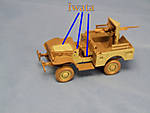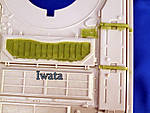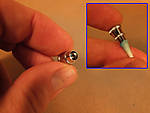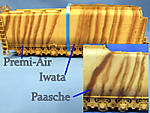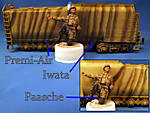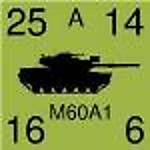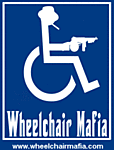1⁄1Airbrush Triple Treat Comparison
20
Comments
Iwata BR
The last brush up (certainly no reflection on it's standing or appeal) is the Iwata Revolution BR. Iwata has developed a reputation as the cream of the crop in the airbrush community. Their line of brushes is long and wide. You can find a brush for every task for every type of profession. This brush fits right in, it's a small streamlined highly engineered brush. When you take it apart there isn't a lot inside, it's a standard construction type brush. There were no surprises inside. All the parts were well engineered and easy to disassemble and reassemble. You will need the included wrench to remove the nozzle. Be very careful with these very small delicate parts. The needle slide is easy and smooth. The trigger was even and consistent.While examining this brush the cup will catch your eye because it is very small itís the smallest of the lot. You will definitely have to mix your paint separately container and pour it in the brush as your painting session progresses. There was no cup cap on this brush, no tipping.
The trigger is a convex depression with an aggressive rim of ridges for grip.
The hose adapter matched my air supply hose so I did not have to worry about an adapter. Once connected, I sprayed some water through it to test the feel and atomization. The trigger was firm and consistent. The feel was responsive and well engineered. As the water came out it was very well atomized and was a fine mist. The spray was even and consistent.
Test Patterns
Again I started with the Blue X4 line test. I mixed up some Tamiya X4 Blue in a small container (paint, water, and a touch of soap), ready to pour into the small cup. I was pleased at how easy this brush was to use. The effort required to get thin lines was very slight. The brush seemed to do all the work. As I moved up and down the paper the paint kept flowing evenly and uniformly. As I pulled back on the trigger releasing more paint the results were very predictable and smooth. There was no 'jump' or 'step' in how thick any of the lines were or how much paint came out. As you can see from the image the lines ran from a tight 1mm up to about 5mm. The top end was not as wide/large as the other two brushes.
Base Coat
When I moved to the base coat test my first concern was the size of the cup. I was not able to cover this smallish Hasegawa Egg Plane with one cup. While the brush was full it acted well. It was easy to spray and the coverage was good. The paint coverage was nice, not thick or thin. It was just right. With a focus on small brushing this brush made the transition to tight spots very easy. I went from wide open spraying to getting into nooks and crannies. The trigger was easy to hold and keep in place. The concave nature was not a negative. The ring of ridges was a nice addition, I felt my fingers catching this and keeping grip.
I did find the size of the brush to be a bit awkward in my hand. While actually painting I found myself really 'thinking' about how the brush sat in my hand. I tried a number of different positions and never got really comfortable.
Subject Test
Moving on to the small area testing was great. I used he same two 1/72 scale models focusing on new areas to see if I could accurately (without masks). On the bridge it was very easy to pick out an area and paint it. No problem, the trigger allows you to really stay small. With coverage and shadowing the brush works flawlessly. On the M6 car I was able to cover the hood nicely and focus on the small side space above the driverís side running board. There was no over spray. This test was done with LifeColor paints and the 'feel' of the paint is thinner than Tamiya and I did account for it stroke and style. The brush allowed for easy transition from paint brand to paint brand.
Camo Test
To get another sense of true application use was the camo test, tiger stripe type camo. This brush handled the base coat fine, a few extra passes because of the size of the spray pattern. The Model Masters paint was a good choice with this brush. The flow and thickness of the paint was great. The ease and consistency was solid, getting narrow lines was easy. Moving to the Tamiya paint was easy to do and this brush handled the Tamiya paint better than the other two brushes. The figure in the photo is a 1/35th scale resin figure, he's there for a scale reference.
Clean up
Clean up presented similar challenges to the others. I cleaned this one the same way, empty it, spray water and cleaner through it, disassemble and clean individual parts. The cup size again presented a challenge; the taper and size of the bottom of the cup was a challenge to get to. I was able to adequately; it was just finicky. The nozzle cap crown was easy to clean with a QTip, remove the needle before you clean this, you may bend the incredibly small needle. If you want to remove the needle through the front, you have to use the wrench to remove the nozzle. Again, be careful of the delicate small parts. The diameter of the opening precludes the use of QTip on the internals. You'll just have to run cleaner through it and then use a paper towel and capillary action to draw out the liquids.
1. Spray Test YouTube Link
2. Base Coat Test YouTube Link
3. Bridge Test YouTube Link
Comments
Hi Scott,
Thank you for your effort - it was very interesting to read this review.
Just wanted to bring to your attention that Paasche is also offering fine nozzle/needle combination for the Talon. Please see the link here: LINK
I wonder if the Talon could show better results in terms of fine detail spaying with these ones.
Some idea: another airbrush worth looking at is Peak C-5 carried by bearair.com - it is made on Iwata's factory in Japan, has a 0.3 mm aperture and is basically a little bit altered old Iwata HP-C model with a needle travel adjusting knob thrown in.
Just for information of everybody, if you are interested in a more affordable airbrushes, you can look at PrecisionAire at Bear Air, Master airbrushes at TCP Global at LINK, and Airbrushcity Airbrushes at LINK
You can find affordable air compressors at LINK
In none of the cases I cannot comment on the quality.
HTH,
Regards,
Doncaster
NOV 08, 2008 - 04:07 PM
must say im quite geard towards getting the premi-air for xmas, anythings better than me old badger, plus for 100 £ i get a compressor with it
NOV 11, 2008 - 08:38 AM
I'm currently using the Paasche VL double action airbrush. It is a good tool, though there are several things I dislike about it, including the open gravity cup (moving about I have spilled a lot of paint!), the fragile needles that are often damaged by the need to remove them for cleaning (spraying any clear acrylic, for example, gunks it up big time), and the lack of any instruction manual that has left me to figure most things out for myself.
The three airbrushes reviewed here are all similar, but I noticed the Iwata is an entry-level product. I. I am interested for recommendations on something for a more-advanced modeler, though I can see the Paasche is supposed to cover the gamut. I know the Iwatas are admired, but I don't know which model would be best.
FYI I'm using the Paasche D500 30 psi compressor which seems fine with the airbrush I'm using.
NOV 11, 2008 - 08:50 AM
Hey guys
Can someone tell me if this is true, the rumors i have heard are that the Talon cannot shoot enamels? I really liked the look of the Talon and down the road was thinking about getting one but i use strictly enamels only.
Thanks in Advance.
Jerry
JAN 02, 2009 - 05:03 AM
Nice artical. However he did not mention that you can get the Iwata Revolution with a larger cup size and a .5mm nozzel for painting larger areas. I use mine for base coats and an Iwata HP-C for my fine work.
MAR 10, 2012 - 05:06 PM
That's a great article. One question, how would you evaluate the G35 for larger scales/areas to cover?
Matt
MAR 11, 2012 - 01:53 PM
I've been using a G35 for ages and I find it covers large areas with ease. The paint cup isn't too large though, so if you are doing a ship or a big base or something then a couple of re-fills will be needed but the actual spraying is brilliant- it is a real workhorse of an AB.
MAR 12, 2012 - 01:02 AM
Hi Matt,
I've got a G35 and use it for all my 1:35 tanks. It can take multiple passes to cover big areas, but then again I tend to "layer" my paint in thinned coats anyway to get some tonal variation so it's ok if I fail to get a good overlap. However, where I've needed a good solid coat it did the job well enough. If you're doing really big stuff and need to solidly cover more than a half-inch-wide stripe with each pass you'll probably need an external-mix firehose like the old Badger 350 that I also have.
Hope this helps!
Tom
MAR 12, 2012 - 01:10 AM
I may have to get one. My Badger is beginning to break down and I've been looking for a solid, reliable airbrush for basic use as a replacement. That prices is awfully hard to beat!
Matt
MAR 12, 2012 - 02:10 AM
Copyright ©2021 by Scott Lodder. Images and/or videos also by copyright holder unless otherwise noted. The views and opinions expressed herein are solely the views and opinions of the authors and/or contributors to this Web site and do not necessarily represent the views and/or opinions of Armorama, KitMaker Network, or Silver Star Enterrpises. All rights reserved. Originally published on: 2008-11-04 00:00:00. Unique Reads: 62234




